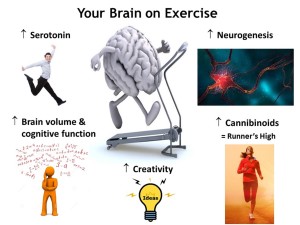When I wrote The Inner Runner, one of the things I wanted to address is how running changes us on the inside. Exercise doesn’t just affect the heart and muscles; it also affects the brain. It’s an interesting field of science called neuroplasticity—the ability of the brain to change.
Running causes morphological and neurochemical adaptations in the brain. It increases the volume of every region of your brain, including the frontal lobe, temporal lobe, parietal lobe, and hippocampus, and prevents the atrophy that often accompanies aging. Conversely, an inactive daily life is a risk factor for brain atrophy, specifically of the frontal lobe—the part of the brain responsible for emotions, problem solving, reasoning, and planning. Specifically, it affects your ability to recognize future consequences resulting from current actions, the choice between good and bad actions, the suppression of socially unacceptable responses, and your ability to determine similarities and differences between things or events. All of these factors are negatively affected with lack of exercise as you age and positively affected by staying or becoming active. Running also facilitates the interaction between the frontal lobe’s prefrontal cortex and the amygdala. The prefrontal cortex is the part of the brain’s frontal lobe that helps dampen the amygdala’s fear and anxiety signals. With fewer constraints from fear and anxiety, we can think more clearly and freely.
If increasing the volume of your brain isn’t enough to make you more creative, running does something even more spectacular to your brain. It causes neurogenesis—the formation of new neurons—in specific parts of the brain. Previously thought to occur only in the developing brain of a fetus and newborn, it’s now accepted that neurogenesis occurs even in the mature brains of adults. The primary part of the brain where this neurogenesis occurs is the hippocampus, which is located under the cerebral cortex in the medial temporal lobe. The hippocampus is critically important for short-term and long-term memory, spatial navigation, and the regulation of emotions. Interestingly, it is one of the first regions of the brain to suffer damage in patients with Alzheimer’s disease.

The hippocampus also contains high levels of glucocorticoid receptors, which makes it more vulnerable to long-term stress than most other areas of the brain. Studies have shown that animals that exercise undergo a sustained increase in neurogenesis in the hippocampus compared to animals that don’t exercise. For example, when mice are given free access to a running wheel for a few months, they have more than twice the number of new cells formed in their brains compared to mice with no access to a running wheel.
Neurogenesis also means that running makes you smarter. Increased interactions between nerve cells means more parts of your brain can communicate with one another. And all this communication fosters what scientists call divergent thinking—what we call thinking outside of the box. A number of studies have shown that running improves fluid intelligence, including problem-solving ability, memory, learning, and pattern recognition. These improvements in cognitive function are even more observable as people age. Indeed, there is considerable evidence that lack of physical activity in the elderly is a risk factor for poor cognitive functioning. It seems that if you want to remain mentally sharp as you age, you had better run, or at least do some form of exercise. Physical activity triggers molecular and cellular changes that support and maintain brain plasticity. Studies have shown that physical activity sustains cerebral blood flow, increases nutrient supply to the brain, and facilitates neurotransmitter metabolism, all of which help you to think better.
[tweetthis]Running makes you smarter because of Increased interactions between nerve cells in your brain.[/tweetthis]
It’s likely that the relationship between physical activity and cognitive performance is reciprocal—increased physical activity leads to better cognitive functioning, and brighter people exercise more. I don’t know that I run because I’m smart or that I’m smart because I run, but I know that running enables me to think in ways that I probably wouldn’t if I didn’t run.
And what about that runner’s high everyone talks about? I swear I must be endorphin-deficient because I don’t ever recall feeling euphoric during or after a run. It turns out that the runner’s high is not due to endorphins after all. Endorphins are released into the blood stream from the pituitary gland and can only marginally enter the brain through the blood-brain barrier. Studies have shown that running activates opioid and cannabinoid receptors, releasing these chemical compounds in the frontolimbic region of the brain after sustained moderate- or high-intensity aerobic exercise. There is a high correlation of opioids and cannabinoids to the perceived euphoria of runners. So when you run, your brain is literally on drugs.
